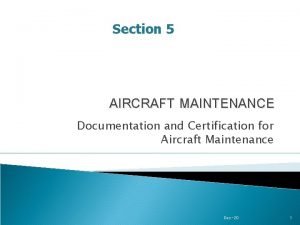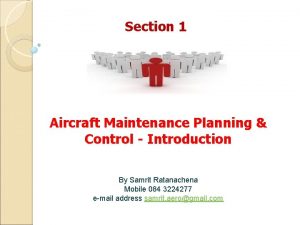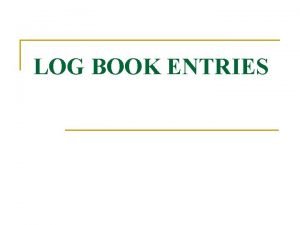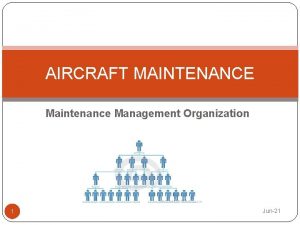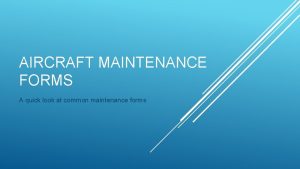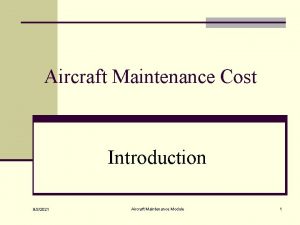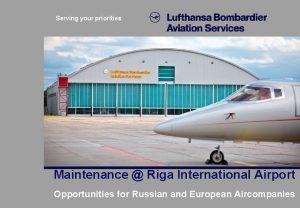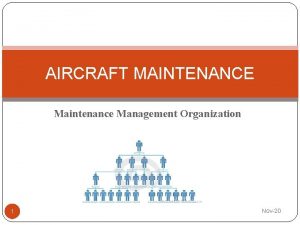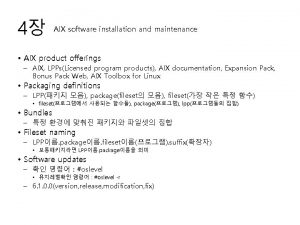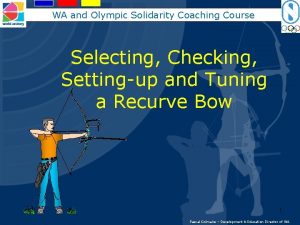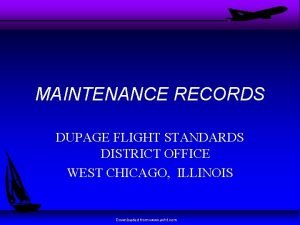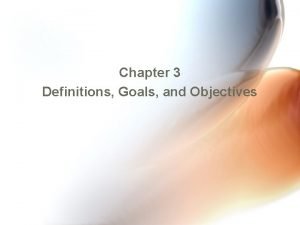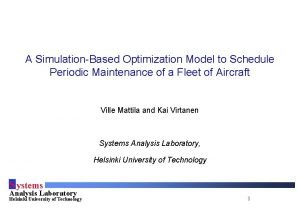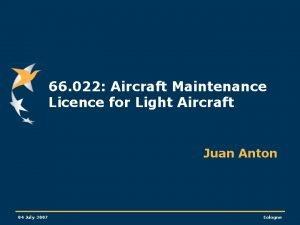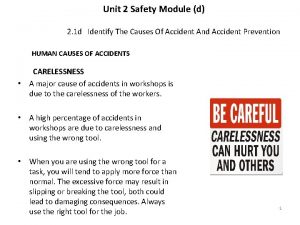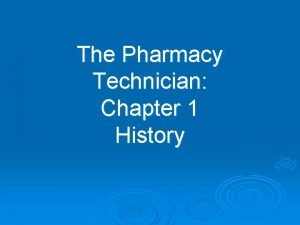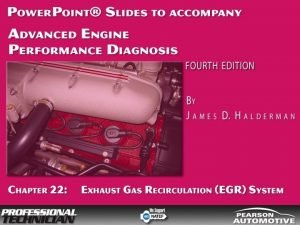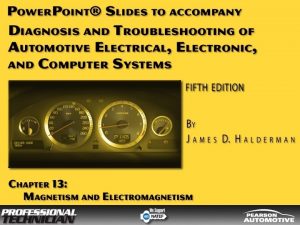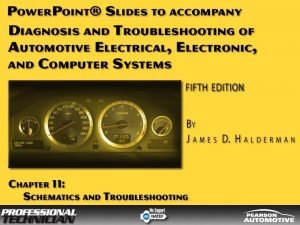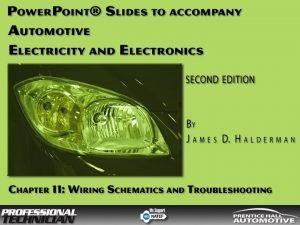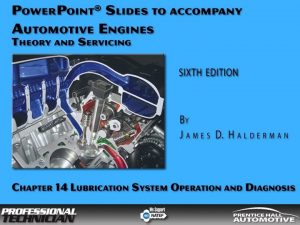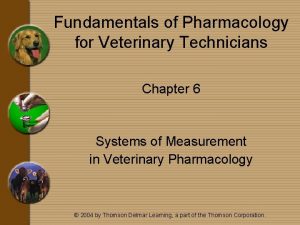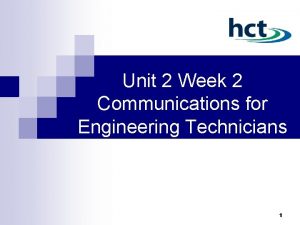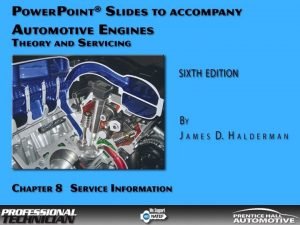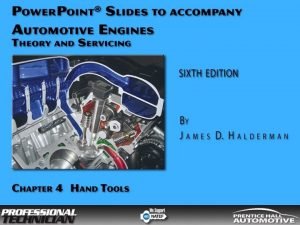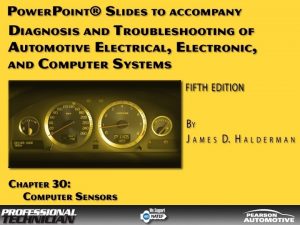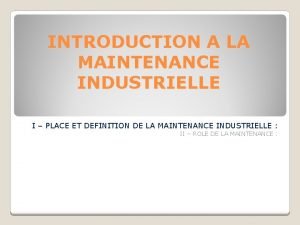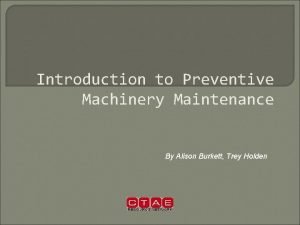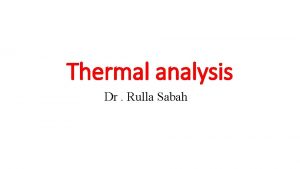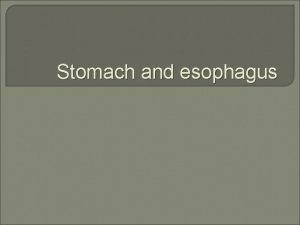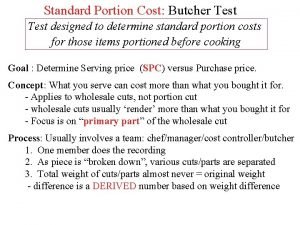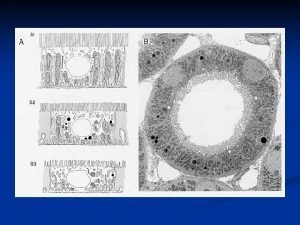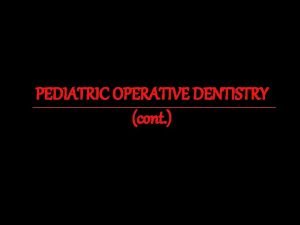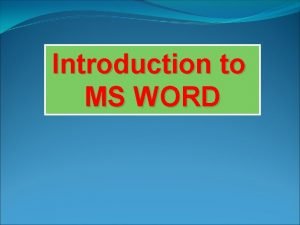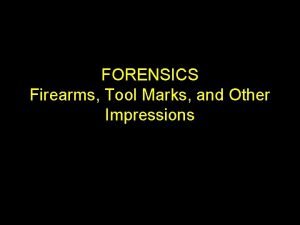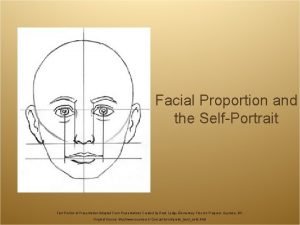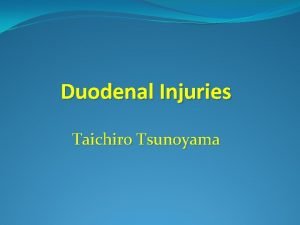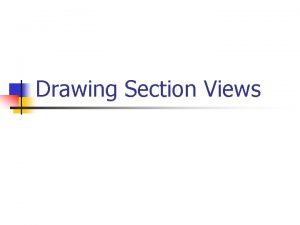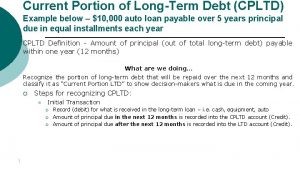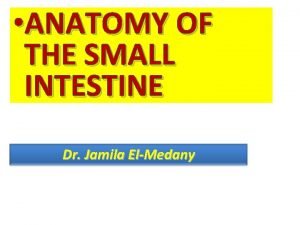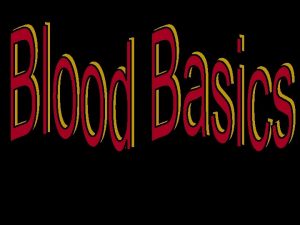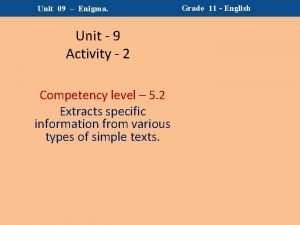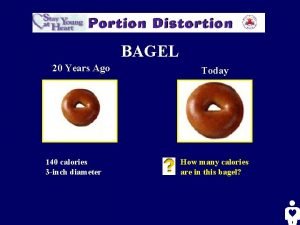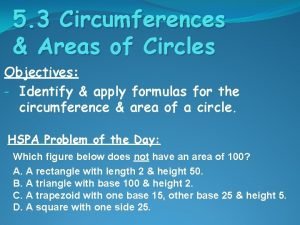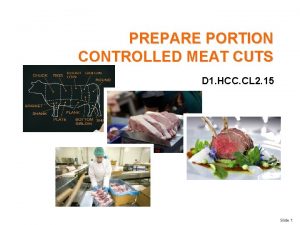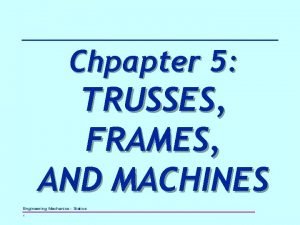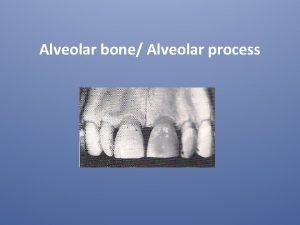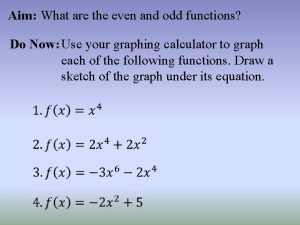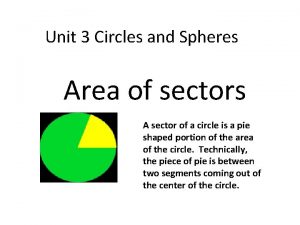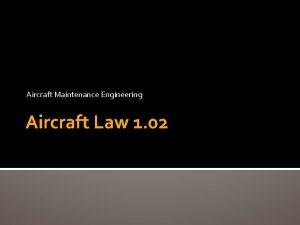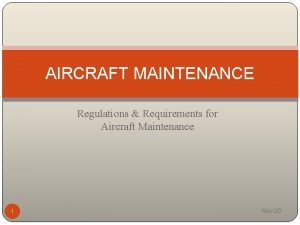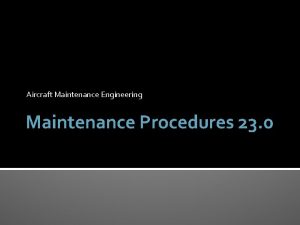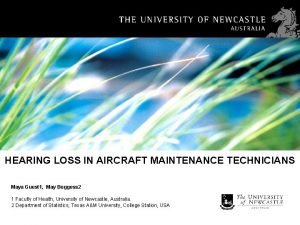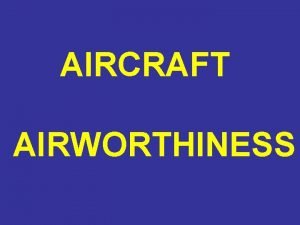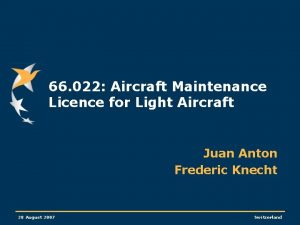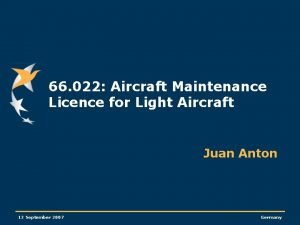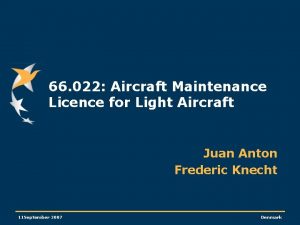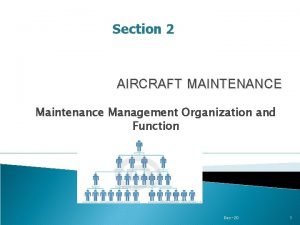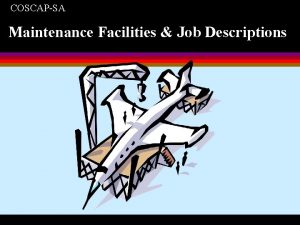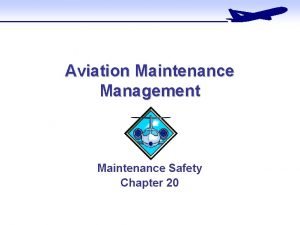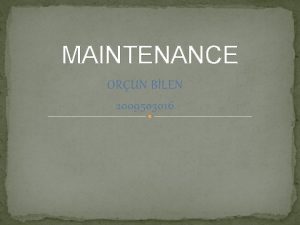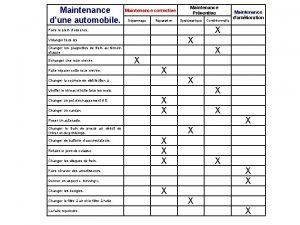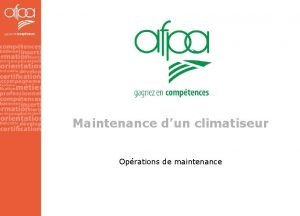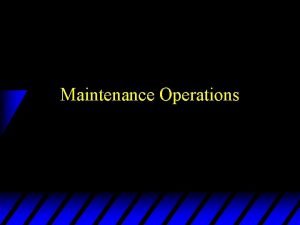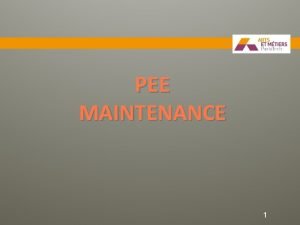INTRODUCTION Aircraft maintenance technicians devote a portion of








































































- Slides: 72

INTRODUCTION Aircraft maintenance technicians devote a portion of their aviation career to ground handling and operating aircraft. Technicians also need to be proficient in operating ground support equipment. The complexity of support equipment and the hazards involved in the ground handling of aircraft require that maintenance technicians possess a detailed knowledge of safety procedures used in aircraft servicing, taxiing, run up, and in the use of ground support equipment. The information provided in this chapter is intended as a general guide for safely servicing and operating aircraft.

Human factors should be introduced to aircraft maintenance personnel to make them aware of how it affects the maintenance performed. Some of these include fatigue, deadline pressure, stress, distractions, poor communication skills, complacency, and lack ofinformation.

Shop Safety Keeping hangars, shop, and the flight line orderly and clean is essential to safety and efficient maintenance. The highest standards of orderly work arrangements and cleanliness should be observed during the maintenance of aircraft. Where continuous work shifts are established, the outgoing shift should remove and properly store personal tools, rollaway boxes, all workstands, maintenance stands, hoses, electrical cords, hoists, crates, and boxes that were needed for the work to be accomplished.

Signs should be posted to indicate dangerous equipment or hazardous conditions. There should also be signs that provide the location of first aid andfire equipment. Safety lanes, pedestrian walkways, and fire lanes should be painted around the perimeter inside the hangars. This is a safety measure to prevent accidents and to keep pedestrian traffic out of work areas. Safety is everyone’s business, and communication is key to ensuring everyone’s safety. Technicians and supervisors should watch for their own safety and forthe safety of others working around them. If other personnel are conducting their actions in an unsafemanner, communicate with them, reminding them of their safety and that of others around them.

Electrical Safety Physiological Safety Working with electrical equipment poses certain physiological safety hazards. It is known that when electricity is applied to the human body, it can create severe burns in the area of entrance to and at the point of exit from the body. In addition, the nervous system is affected and can be damaged or destroyed. To safely deal with electricity, the technician must have a working knowledge of the principles of electricity, and a healthy respect for its capability to do both work and damage.

Wearing or use of proper safety equipment can provide a psychological assurance at the same time it physically protects the user. The use of rubber gloves, safety glasses, rubber or grounded safety mats, and other safety equipment contributes to the physiological safety of the technician working on or with electrical equipment. Two factors that affect safety when dealing with electricity are fear and overconfidence. These two factors are major causes of accidents involving electricity. While both a certain amount of respect for electrical equipment is healthy and a certain level of confidence

Safety Around Compressed Gases Compressed air, like electricity, is an excellent tool as long as it is under control. The following “do’s and don’ts” apply when working with or around compressed gases: • Inspect air hoses frequently for breaks and worn spots. Unsafe hoses should be replaced immediately. • Keep all connections in a “no-leak condition. ” • Maintain in-line oilers, if installed, in operating condition. • The system should have water sumps installed and should be drained at regular intervals.

• Air used for paint spraying should be filtered to remove oil and water. • Never use compressed air to clean hands or clothing. Pressure can force debris into the flesh leading to infection. • Never spray compressed air in the area of other personnel. • Air hoses should be straightened, coiled, and properly stored when not in use. When inflating tires on any type of aircraft wheels, always use tire cage guards. Tire cages need not be used when adjusting pressure in

Safety Around Hazardous Material safety diamonds are very important with regard to shop safety. These forms and labels are a simple and quick way to determine the risk and, if used properly with the tags, will indicate what personal safety equipment to use with the hazardous material. The most observable portion of the Material Safety Data Sheet (MSDS) label is the risk diamond. It is a four color segmented diamond that represents Flammability (Red), Reactivity (Yellow), Health (Blue), and special Hazard (White). In the Flammability, Reactivity, and Health blocks, there should be a number from 0 to 4. Zero represents little or no hazard to the user; 4 means that the material is very hazardous. The special hazard segment contains a word or abbreviation to represent the special hazard. Some examples are: RAD for radiation, ALK for alkali materials, Acid for acidic materials, and CARC for carcinogenic materials. The letter W with a line through it stands for high reactivity to water. [Figure 11 -2]


Safety Around Machine Tools Hazards in a shop’s operation increase when the operation of lathes, drill presses, grinders, and other types of machines are used. Each machine has its own set of safety practices. The following discussions regarding precautions should be followed to avoid injury. The drill press can be used to bore and ream holes, to do facing, milling, and other similar types of operations. The following precautions can reduce the chance of injury: • Wear eye protection. • Securely clamp all work. • Set the proper RPM for the material used. • Do not allow the spindle to feed beyond its limit of travel while drilling. • Stop the machine before adjusting work or attempting to remove jammed work.

Lathes are used in turning work of a cylindrical nature. This work may be performed on the inside or out side of the cylinder. The work is secured in the chuck to provide the rotary motion, and the forming is done by contact with a securely mounted tool. The following precautions can reduce the chance of injury: • Wear eye protection. • Use sharp cutting tools. • Allow the chuck to stop on its own. Do not attempt to stop the chuck by hand pressure. • Examine tools and work for cracks or defects before starting the work. • Do not set tools on the lathe. Tools may be caught by the work and thrown. • Before measuring the work, allow it to stop in the lathe.

Milling machines are used to shape or dress; cut gear teeth, slots, or key ways; and similar work. The following precautions can reduce the chance of injury: • Wear eye protection. • Clean the work bed prior to work. • Secure the work to the bed to prevent movement during milling. • Select the proper tools for the job. • Do not change the feed speed while working. • Lower the table before moving under or away from the work. • Ensure all clamps and bolts will pass under the arbo

Grinders are used to sharpen tools, dress metal, and perform other operations involving the removal of small amounts of metal. The following precautions can reduce the chance of injury: • Wear eye protection even if the grinder has a shield. • Inspect the grinding wheel for defects prior to use. • Do not force grinding wheels onto the spindle. They fit snugly, but do not require force to install them. Placing side pressure on a wheel could cause it to explode. • Check the wheel flanges and compression washer. They should be one-third the diameter of the wheel. • Do not stand in the arc of the grinding wheel while operating, in case the wheel explodes.

Welding should be performed only in designated areas. Any part to be welded should be removed from the aircraft, if possible. Repair would then be accomplished in the welding shop under a controlled environment. A welding shop should be equipped with proper tables, ventilation, tool storage, and fire prevention and extinguishing equipment. Welding on an aircraft should be performed outside, if possible. If welding in the hangar is necessary, observe these precautions: • During welding operations, there should be no open fuel tanks, and no work on fuel systems should be in progress. • No painting should be in progress. • No aircraft are to be within 35 feet of the welding operation.

• No flammable material should be in the area around the welding operation. • Only qualified welders should be permitted to do the work. • The welding area should be roped off and placarded. • Fire extinguishing equipment of a minimum rating of 20 B should be in the immediate area with 80 B rated equipment as a backup. • There should be trained fire watches in the area around the welding operation. • Aircraft being welded should be in towable condition, with a tug attached, and the aircraft parking brakes released. A qualified operator should be on the tug, and mechanics available to assist in the towing operation should it become necessary to tow the aircraft. If the aircraft is in the hangar, the hangar doors should be opened.

Flight Line Safety Hearing Protection The flight line is a place of dangerous activity. Technicians who perform maintenance on the flight line must constantly be aware of what is going on around them. §The noise on a flight line comes from many places. Aircraft are only one source of noise. There auxiliary-power units (APUs), fuel trucks, baggage handling equipment, and so forth. Each has its own frequency of sound. Combined all together, the ramp or flight line can cause hearing loss. §There are many types of hearing protection available. Hearing protection can be external or internal. The external protection is the earmuff/headphone type. The internal type fit into the auditory canal. Both types will reduce the sound level reaching the eardrum and reduce the chances of hearing loss.

Foreign Object Damage (FOD) ØFOD is any damage caused by any loose object to aircraft, personnel, or equipment. These loose objects can be anything from broken runway concrete to shop towels to safety wire. ØTo control FOD, keep ramp and operation areas clean, have a tool control program, and provide convenient receptacles for used hardware, shop towels, and other consumables. ØThe modern gas turbine engine will create a low pressure area in front of the engine that will cause any loose object to be drawn into the engine. The exhaust of these engines can propel loose objects great distances with enough force to damage anything that is hit.

Safety Around Airplanes As with the previously mentioned items, it is important to be aware of propellers. Do not assume the pilot of a taxiing aircraft can see you. Technicians must stay where the pilot can see them while on the ramp area. Turbine engine intakes and exhaust can also be very hazardous areas. There should be no smoking or open flames anywhere near an aircraft in operation. Be aware of aircraft fluids that can be detrimental to skin. When operating support equipment around aircraft, be sure to allow space between it and the aircraft and secure it so it cannot roll into the aircraft. All items in the area of operating aircraft must be stowed properly.

Safety Around Helicopters Every type of helicopter has its own differences. These differences must be learned to avoid damaging the helicopter or injuring the technician. When approaching a helicopter while the blades are turning, observe the rotor head and blades to see if they are level. This will allow maximum clearance as you approach the helicopter. Observe the following: • Approach the helicopter in view of the pilot. • Never approach a helicopter carrying anything with a vertical height that the blades could hit.

• Never approach a single-rotor helicopter from the rear. The tail rotor is invisible when operating. • Never go from one side of the helicopter to the other by going around the tail. Always go around the nose of the helicopter. When securing the rotor on helicopters with elasto-metric bearings, check the maintenance manual for the proper method. Using the wrong method could damage the bearing.

Fire Safety Performing maintenance on aircraft and their components requires the use of electrical tools which can produce sparks, along with heat-producing tools and equipment, flammable and explosive liquids, and gases. As a result, a high potential exists for fire to occur. Measures must be taken to prevent a fire from occurring and to also have a plan for extinguishing it.

Fire Protection Requirements for Fire To Occur Three things are required for a fire: (1) fuel — something that will, in the presence of heat, combine with oxygen, thereby releasing more heat and as a result reduces itself to other chemical compounds; (2) heat — accelerates the combining of oxygen with fuel, in turn releasing more heat; and (3) oxygen — the element which combines chemically with another substance through the process of oxidation. Rapid oxidation, accompanied by a noticeable release of heat and light, is called combustion or burning. [Figure 11 -3] Remove any one of these things and the fire extinguishes.

Classification of Fires For commercial purposes, the National Fire Protection Association (NFPA) has classified fires into three basic types: Class A, Class B, and Class C. 1. Class A fires occur in ordinary combustible materials, such as wood, cloth, paper, upholstery materials, and so forth. 2. Class B fires occur in flammable petroleum products of other flammable or combustible liquids, greases, solvents, paints, and so forth. 3. Class C fires occur involve energized electrical wiring and equipment.

A fourth class of fire, with which the technician should be familiar, the Class D fire, is defined as fire in flammable metal. Class D fires are not commercially considered by the National Fire Protection Association to be a basic type or category of fire since they are caused by a Class A, B, or C fire. Usually Class D fires involve magnesium in the shop or in aircraft wheels and brakes, or are the result of improper or poorly conducted welding operations.


Types and Operation of Shop and Flight Line ØFire Extinguishers Water extinguishers are the best type to use on Class A fires. Water has two effects on fire: it deprives fire of oxygen and cools the material being burned. ØSince most petroleum products float on water, water-type fire extinguishers are not recommended for Class B fires. ØNever use water-type fire extinguishers on Class D fires. Because metals burn at extremely high temperatures, the cooling effect of water causes an explosive expansion of the metal.

ØCarbon dioxide (CO 2) extinguishers are used for Class A, B, and C fires, extinguishing the fire by depriving it of oxygen. [Figure 11 -4] Additionally, like water-typeextinguishers, CO 2 cools the burning material.

ØNever use CO 2 on Class D fires. As with water extinguishers the cooling effect of CO 2 on the hot metal can cause explosive expansion of the metal. ØExtreme caution must be used when operating CO 2 fire extinguishers in closed or confined areas. Not only can the fire be deprived of oxygen, but so too can the operator ØHalogenated hydrocarbon extinguishers are most effective on Class B and C fires. They can be used on Class A and D fires but they are less effective. Halogenated hydrocarbon, (commonly called Freon™ by the industry), are numbered according to chemical formulas with Halon™ numbers. ØCarbon tetrachloride (Halon 104), chemical formula CCl 4, has an Underwriters Laboratory (UL) toxicity rating of 3. As such, it is extremely toxic. [Figure 11 -6]


ØDry powder extinguishers, while effective on Class B and C fires, are the best for use on Class D fires. ØDry powder is not recommended for aircraft use(except on metal fires as a fire extinguisher) because the leftover chemical residues ØInspection of Fire Extinguishers Fire extinguishers should be checked periodically utilizing a checklist. If a checklist is unavailable, check the following as a minimum: • Proper location of appropriate extinguisher • Safety seals unbroken • All external dirt and rust removed • Gauge or indicator in operable range • Proper weight • No nozzle obstruction • No obvious damage



Tie down Procedures for Land Planes Securing Light Aircraft Light aircraft are most often secured with ropes tied only at the aircraft tie down rings provided for securing purposes. Rope should never be tied to a lift strut, since this practice can bend a strut if the rope slips to a point where there is no slack. Manila rope shrinks when wet; about 1 inch (1") of slack should be provided for movement. Too much slack allows the aircraft to jerk against the ropes. Tight tie down ropes put inverted flight stresses on the aircraft, many of which are not designed to take such loads.

A tie down rope holds no better than the knot. Antislip knots such as the bowline are quickly tied and are easy to untie. [Figure 11 -10] Aircraft not equipped with Tie down fittings should be secured in accordance with the manufacturer’s instructions. Ropes should be tied to outer ends of struts on high-wing monoplanes, and suitable rings should be provided where structural conditions permit, if the manufacturer has not already provided them.


Tie down Procedures Preparation of Aircraft should be tied down after each flight to prevent damage from sudden storms. The direction in which aircraft are to be parked and tied down is determined by prevailing or forecast wind direction. Aircraft should be headed as nearly as possible into the wind, depending on the locations of the parking area’s fixed tie down points. Spacing of tie downs should allow for ample wingtip clearance. [Figure 11 -9] After the aircraft is properly located, lock the nose wheel or the Tail wheel in the fore-and-aft position.


Securing Heavy Aircraft The normal tie down procedure for heavy aircraft can be accomplished with rope or cable tie down. The number of such tie downs should be governed by anticipated weather conditions. Most heavy aircraft are equipped with surface control locks, which should be engaged or installed when the aircraft is secured. The normal tie down procedure for heavy aircraft should generally include the following: 1. Head airplane into prevailing wind whenever possible. 2. Install control locks, all covers and guards. 3. Chock all wheels fore and aft.

4. Attach tie down reels to airplane tie down loops and to tie down anchors or tie down stakes. Use tie down stakes for temporary tie down only. If tie down reels are not available, 1/4" wire cable or 11⁄2" manila line may be used.


Towing of Aircraft Movement of large aircraft on an airport and about the flight line and hangar is usually accomplished by towing with a tow tractor (sometimes called a “tug”). [Figure 11 -19] In the case of small aircraft, some moving is accomplished by hand, by pushing on the correct areas of the aircraft. Aircraft may also be taxied about the flight line, but usually only by certain qualified persons. Before the aircraft to be towed is moved, a qualified person must be in the cockpit to operate the brakes in case

The following towing and parking procedures are typical of one type of operation. Only competent persons properly checked out should direct an aircraft towing team. 1. The towing vehicle driver is responsible for operating the vehicle in a safe manner and obeying emergency stop instructions given by any team member. 2. The person in charge should assign team personnel as wing walkers. A wing walker should be stationed at each wingtip in such a position that he or she can ensure adequate clearance of any obstruction in the path of the aircraft. A tail walker should be assigned when sharp turns are to be made, or when the aircraft is to be backed into position.

3. A qualified person should occupy the pilot’s seat of the towed aircraft to observe and operate the brakes as required. When necessary, another qualified person is stationed to watch and maintain aircraft hydraulic system pressure. 4. The person in charge of the towing operation should verify that, on aircraft with a steerable Nose wheel, the locking scissors are set to full swivel for towing. The locking device must be reset after the tow bar has been removed from the aircraft. Persons stationed in the aircraft should not attempt to steer or turn the nose wheel when the tow bar is attached to the aircraft.

5. Under no circumstances should anyone be permitted to walk or to ride between the nose wheel of an aircraft and the towing vehicle, nor ride on the outside of a moving aircraft or on the towing vehicle. In the interest of safety, no attempt to board or leave a moving aircraft or towing vehicle should be permitted. 6. The towing speed of the aircraft should not exceed that of the walking team members. The aircraft’s engines usually are not operated when the aircraft is being towed into position. 7. The aircraft brake system should be charged before each towing operation. Aircraft with faulty brakes should be towed into position only for repair of brake systems, and then only with personnel standing by ready with chocks for emergency use. Chocks must be immediately available in case of an emergency

8. To avoid possible personal injury and aircraft damage during towing operations, entrance doors should be closed, ladders retracted, and gear down locks installed. 9. Prior to towing any aircraft, check all tires and landing gear struts for proper inflation. (Inflation of landing gear struts of aircraft in overhaul and storage is excluded. ) 10. When moving aircraft, do not start and stop suddenly. For added safety, aircraft brakes must never be applied during towing except in emergencies, and then only upon command by one of the tow team members.

11. Aircraft should be parked in specified areas only. Generally, the distance between rows of parked aircraft should be great enough to allow immediate access of emergency vehicles in case of fire, as well as free movement of equipment and materials. 12. Wheel chocks should be placed fore and aft of the main landing gear of the parked aircraft. 13. Internal or external control locks (gust locks or blocks) should be used while the aircraft is parked. 14. Prior to any movement of aircraft across runways or taxiways, contact the airport control tower on the appropriate frequency for clearance to proceed. 15. An aircraft should not be parked in a hangar without immediately being statically grounded.

Taxiing Aircraft As a general rule, only rated pilots and qualified airframe and power plant technicians are authorized to start, run up, and taxi aircraft. All taxiing operations should be performed in accordance with applicable local regulations. Taxi Signals Many ground accidents have occurred as a result of improper technique in taxiing aircraft. Although the pilot is ultimately responsible for the aircraft until the engine is stopped, a taxi signalman can assist the pilot around the flight line. The standard position for a signalman is slightly ahead of and in line with the aircraft’s left wingtip. As the signalman faces the aircraft, the nose of the aircraft is on the left.


JACKING AIRCRAFT The aviation technician must be familiar with the jacking of aircraft in order to perform maintenance and inspection. Since jacking procedures and safety precautions vary for different types of aircraft, only general jacking procedures and precautions are discussed. Consult the applicable aircraft manufacturer's maintenance instructions for specific jacking procedures. Extensive aircraft damage and serious personal injury have resulted from careless or improper jacking procedures. As an added safety measure, jacks should be inspected before use to determine the specific lifting capacity, proper functioning of safety locks, condition of pins, and general serviceability.

Before raising an aircraft on jacks, all work stands and other equipment should be removed from under and near the aircraft. No one should remain in the aircraft while it is being raised or lowered, unless maintenance manual procedures require such practice for observing leveling instruments in the aircraft. The aircraft to be jacked must be located in a level position, well protected from the wind. A hangar should be used if possible. The manufacturer's maintenance instructions for the aircraft being jacked should be consulted for the location of the jacking points. These jacking points are usually located in relation to the aircraft center of gravity so the aircraft will be well balanced on the

On some aircraft it may be necessary to add weight to the nose or tail of the aircraft to achieve a safe balance. Sandbags are usually used for this purpose. Jacking Complete Aircraft Prior to jacking the aircraft, an overall survey of the complete situation should be made to determine if any hazards to the aircraft or personnel exist. Tripod jacks of the appropriate size for the aircraft being jacked should be placed under the aircraft jacking points and perfectly centered to prevent them from cocking when the aircraft is raised. The legs of the jacks should be checked to see that they will not interfere with the operations to be performed after the aircraft is jacked, such as retracting the landing

At least three places or points are provided on aircraft for jacking purposes; a fourth place on some aircraft is used to stabilize the aircraft while it is being jacked at the other three points. The two main places are on the wings, with a smaller one on the fuselage near either the tail or the nose, depending on the landing gear design. Most aircraft have jack pads located at the jack points. Others have removable jack pads that are inserted into receptacles bolted in place prior to jacking. The correct jack pad should be used in all cases. The function of the jack pad is to ensure that the aircraft load is properly distributed at the jack point and to provide a convex bearing surface to mate with the concave jack stem.

Prior to jacking, determine if the aircraft configuration will permit jacking. There may be equipment or fuel which has to be removed if serious structural damage is to be avoided during jacking. If any other work is in progress on the aircraft, ascertain if any critical panels have been removed. On some aircraft the stress panels or plates must be in place when the aircraft is jacked to avoid structural damage. Extend the jacks until they contact the jack pads. A final check for alignment of the jacks should be made before the aircraft is raised, since most accidents during jacking are the result of misaligned jacks.

When the aircraft is ready to be raised, a man should be stationed at each jack. The jacks should be operated simultaneously to keep the aircraft as level as possible and to avoid overloading any of the jacks. This can be accomplished by having the crew leader stand in front of the aircraft and give instructions to the men operating the jacks. Caution should be observed, since on many jacks the piston can be raised beyond the safety point; therefore, never raise an aircraft any higher than is necessary to accomplish the job.

The area around the aircraft should be secured while the aircraft is on jacks. Climbing on the aircraft should be held to an absolute minimum, and no violent movements should be made by persons who are required to go aboard. Any cradles or necessary supports should be placed under the fuselage or wings of the aircraft at the earliest possible time, particularly if the aircraft is to remain jacked for any length of time. On collet equipped jacks, the collet should be kept within two threads of the lift tube cylinder during raising, and screwed down firmly to the cylinder after jacking is completed to prevent settling.

Before releasing jack pressure and lowering the aircraft, make certain that all work stands, equipment, and persons are clear of the aircraft, that the landing gear is down and locked, and that all ground locking devices are properly installed.



Jacking One Wheel of an Aircraft When only one wheel has to be raised to change a tire or to grease wheel bearings, a low single base jack(Bottle jack) is used. Before the wheel is raised, the remaining wheels must be chocked fore and aft to prevent movement of the aircraft. If the aircraft is equipped with a tail wheel, it must be locked. The wheel should be raised only high enough to clear the concrete surface.


Fuel Servicing Of Aircraft Types of Fuel and Identification Two types of aviation fuel in general use are aviation gasoline, also known as AVGAS, and turbine fuel, also known as JET A fuel. Aviation gasoline (AVGAS) is used in reciprocating engine aircraft. Currently, there are three grades of fuel in general use: 80/87, 100/130, and 100 LL (low lead). A fourth grade, 115/145, is in limited use in the large reciprocating-engine aircraft. The two numbers indicate the lean mixture and rich mixture octane rating numbers of the specific fuel. In other words, with 80/87 aviation gasoline, the 80 is the lean mixture rating and 87 is the rich mixture rating number. AVGAS can also be identified by a color code. The color of the fuel should match the


Three types of turbine fuel generally used in civilian aviation are JET A and JET A-1, which are made from kerosene and JET B, which is a blend of kerosene and aviation gasoline. While jet fuel is identified by the color black on piping and fueling equipment, the actual color of jet fuel can be clear or straw colored. Never mix AVGAS and turbine fuel.

Contamination Control Contamination is anything in the fuel that is not supposed to be there. The types of contamination found in aviation fuel include water, solids, and microbial growths. The best method of controlling contamination is to prevent its introduction into the fuel system. Some forms of contamination will still occur inside the fuel system. Either way, the filter, separators, and screens should remove most of the contamination. Water in aviation fuels will generally take two forms: dissolved (vapor) and free water. Solid contaminants are insoluble in fuel. The more common types are rust, dirt, sand, gasket material, lint, and fragments of shop towels.

Microbiological growths are a problem in jet fuel. There a number of varieties of micro-organisms that can live in the free water in jet fuel. Fueling Procedures There are two basic procedures when fueling an aircraft. Smaller aircraft are fueled by the over-the-wing method. This method uses the fuel hose to fill through fueling ports on the top of the wing. The method used for larger aircraft is the single point fueling system. This type of fueling system uses receptacles in the bottom leading edge of the wing, which is used to fill all the tanks from this one point.

This decreases the time it takes to refuel the aircraft, limits contamination, and reduces the chance of static electricity igniting the fuel. Most pressure fueling systems consist of a pressure fueling hose and a panel of controls and gauges that permit one person to fuel or defuel any or all fuel tanks of an aircraft. Each tank can be filled to a predetermined level.

Prior to fueling, the person fueling should check the following: 1. Ensure all aircraft electrical systems and electronic devices, including radar, are turned off. 2. Do not carry anything in the shirt pockets. These items could fall into the fuel tanks. 3. Ensure no flame-producing devices are carried by anyone engaged in the fueling operation. A moment of carelessness could cause an accident. 4. Ensure that the proper type and grade of fuel is used. Do not mix AVGAS and JET fuel. 5. Ensure that all the sumps have been drained.

6. Wear eye protection. Although generally not as critical as eye protection, other forms of protection, such as rubber gloves and aprons, can protect the skin from the effects of spilled or splashed fuel. 7. Do not fuel aircraft if there is danger of other aircraft in the vicinity blowing dirt in the direction of the aircraft being fueled. Blown dirt, dust, or other contaminants can enter an open fuel tank, contaminating the entire contents of the tank. 8. Do not fuel an aircraft when there is lightning within 5 miles. 9. Do not fuel an aircraft within 500 feet of operating ground radar.

Defueling can be accomplished by gravity defueling or by pumping the fuel out of the tanks. When the gravity method is used, it is necessary to have a method of collecting the fuel. When the pumping method is used, care must be taken not to damage the tanks, and the removed fuel should not be mixed with good fuel. General precautions when defueling are: • Ground the aircraft and defueling equipment. • Turn off all electrical and electronic equipment. • Have the correct type of fire extinguisher available. • Wear eye protection.


 Devote yourselves to prayer
Devote yourselves to prayer Aircraft reliability program manual
Aircraft reliability program manual Aircraft maintenance planning
Aircraft maintenance planning Example of log book
Example of log book Aircraft maintenance management structure
Aircraft maintenance management structure Aircraft maintenance forms
Aircraft maintenance forms Aircraft maintenance cost breakdown
Aircraft maintenance cost breakdown Execujet berlin eddb
Execujet berlin eddb Mro organization chart
Mro organization chart Aix expansion pack
Aix expansion pack Flightlevel aviation aircraft maintenance
Flightlevel aviation aircraft maintenance Dupage flight center aircraft maintenance
Dupage flight center aircraft maintenance Faa aircraft characteristics database
Faa aircraft characteristics database Maintenance goals and objectives
Maintenance goals and objectives Aircraft maintenance schedule optimization
Aircraft maintenance schedule optimization Licence 66
Licence 66 10 principles of better workmanship for technicians
10 principles of better workmanship for technicians Pharmacotritae
Pharmacotritae Two technicians are discussing clogged egr passages
Two technicians are discussing clogged egr passages An ignition coil operates using the principle of
An ignition coil operates using the principle of An ignition coil operates using the principle of
An ignition coil operates using the principle of Two technicians are discussing schematic symbols
Two technicians are discussing schematic symbols All switches illustrated in schematics are
All switches illustrated in schematics are Two technicians are discussing oil changes
Two technicians are discussing oil changes Fundamentals of pharmacology for veterinary technicians
Fundamentals of pharmacology for veterinary technicians Unit 2 communications for engineering technicians
Unit 2 communications for engineering technicians Two technicians are discussing tire rotation
Two technicians are discussing tire rotation Proper term for channel locks
Proper term for channel locks Two technicians are discussing a stepped ect circuit
Two technicians are discussing a stepped ect circuit Politique de la maintenance
Politique de la maintenance Trey burkett
Trey burkett Proximal convoluted tubule
Proximal convoluted tubule In thermogram the horizontal portion in the curve indicates
In thermogram the horizontal portion in the curve indicates Right and left gastroepiploic arteries
Right and left gastroepiploic arteries Standard portion cost
Standard portion cost Ductnn
Ductnn Portion distortion quiz
Portion distortion quiz Isthmus in conservative dentistry
Isthmus in conservative dentistry Owl purdue memo
Owl purdue memo Vaste externe triceps
Vaste externe triceps Ribbon in ms word meaning
Ribbon in ms word meaning 1990
1990 The indented portion of rifling
The indented portion of rifling Portion vs proportion
Portion vs proportion Pyloric exclusion steps
Pyloric exclusion steps Cut view drawing
Cut view drawing Cpltd dan ltd adalah
Cpltd dan ltd adalah Current portion of long term debt
Current portion of long term debt Precision nutrition portion size
Precision nutrition portion size Jj johnson
Jj johnson What is as purchased
What is as purchased Relations of small intestine
Relations of small intestine Methods of portion control in bread and pastry
Methods of portion control in bread and pastry Yellowish liquid
Yellowish liquid Lions are mostly nocturnal predators phrase or clause
Lions are mostly nocturnal predators phrase or clause Clock face plating
Clock face plating Enigma
Enigma Thou my everlasting portion
Thou my everlasting portion Parts of the sewing machine in the arm and head
Parts of the sewing machine in the arm and head Calculating food cost
Calculating food cost Two sevenths as a percentage
Two sevenths as a percentage Spaghetti calories 1 cup
Spaghetti calories 1 cup Find the area of shaded portion of the given figure.
Find the area of shaded portion of the given figure. Spinal cord diagram
Spinal cord diagram Syzygy
Syzygy The dark inner portion of the shadow cone
The dark inner portion of the shadow cone Portion controlled cuts
Portion controlled cuts Constriction of oesophagus
Constriction of oesophagus Trusses and frames in engineering mechanics
Trusses and frames in engineering mechanics Alveolar portion
Alveolar portion Odd and even function calculator
Odd and even function calculator Areas of circles and sectors practice
Areas of circles and sectors practice Whats an eclipse
Whats an eclipse

